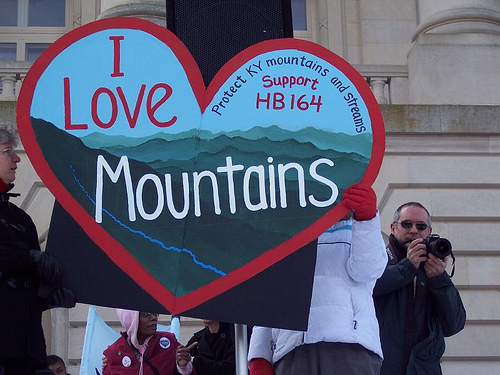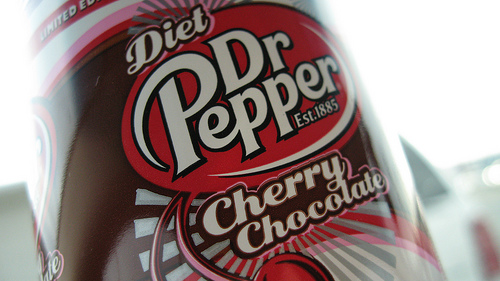 Aspartame in artificially blackened water — tasty.Photo: William HartzWhen I wrote about diet soda and and its health effects last week, I didn’t expect much of a reaction. I guess in the back of my mind, I was thinking, people still drink that stuff?
Aspartame in artificially blackened water — tasty.Photo: William HartzWhen I wrote about diet soda and and its health effects last week, I didn’t expect much of a reaction. I guess in the back of my mind, I was thinking, people still drink that stuff?
Well, they do — by the bucketful. Overall, U.S. soda consumption is declining slowly, but Americans still drink more soda than than anyone else on the planet, by a wide margin. According to one reckoning, the average American drinks 736 “eight-ounce servings” each year (though “eight-ounce serving” seems like a quaint notion in the age of the Big Gulp). I can’t find good figures on how much of that gusher is diet soda, but apparently it’s a lot. According to AdBrands.net, four of the top 10 leading U.S. soda brands are diet versions of big names like Coke and Pepsi.
It’s no wonder, either. This is an industry with upwards of $70 billion in annual U.S. sales, and a significant portion of those proceeds get invested in marketing. As anxiety about the health effects of consuming huge amounts high-calorie sweeteners ramps up, the industry peddles diet drinks as the benign alternative. In a culture as fixated on body image as it is on cheap-and-easy food, the lure of calorie-free cola — all of the addictive qualities and caffeine jolt of regular soda, none of the guilt! — is powerful indeed. (I didn’t even get into the twisted gender/body-image politics of Pepsi’s “skinny can” in my earlier piece.)
So, not surprisingly given the widespread popularity of diet drinks, my piece got lots of reaction. On Twitter, the high-profile political blogger Ezra Klein responded, “Sigh. But I like my diet soda!#knowledgeispain.”
And hence we come to the topic of this post. In response to Klein’s tweet, Adam Ozimek of the Modeled Behavior blog quickly mounted a vigorous defense of aspartame, the artificial sweetener of choice for the soda industry. Ozimek denounced my post as hippie-addled conspiracy mongering. “Don’t you put that soda down, Ezra!” Ozimek thunders. He continues:
You just calmly finish drinking that diet soda and don’t concern yourself for one second. I know you’re worried, because you fearfully tweeted earlier today about this Tom Philpott story at Grist about how diet soda causes cancer. But the best thing you can do for your health is not listen to Tom Philpott, because the unnecessary stress caused by worrying about the aspartame in your diet soda is far more dangerous for you than the aspartame in your soda.
Right. Ozimek goes on to compare my discussion of aspartame’s dodgy ride through the FDA to “‘debating’ whether 9/11 was an inside job.” Oh, snap! And then he sets out to debunk two of my central claims: 1) that aspartame’s approval by the FDA in 1981 came under a cloud of industry political influence; and 2) that a 2006 Italian study implicates aspartame as a possible carcinogen.
Before I get into the substance of Ozimek’s critique, I want to establish that suggesting that industry influence might affect FDA decisions (or those of any regulatory agency) does not amount to 9/11 quackery. Indeed, I’m sad to report, such influence is business as usual — it’s true today, under our current vigorously pro-business, regulation-shy president, just as it was in the early 1980s when the aspartame decision went down, under another pro-business, regulation-shy president, Ronald Reagan.
Last fall, the Union of Concerned Scientists documented the sad state of regulatory-agency independence. Working with Iowa State University, the group surveyed more than 1,700 FDA and USDA employees. The findings are sobering:
More than 620 respondents (38 percent) agreed or strongly agreed that “public health has been harmed by agency practices that defer to business interests.” Three-hundred-and-thirty respondents (27 percent) said they had personally experienced “instances where public health has been harmed by businesses withholding food safety information from agency investigators” in the past year. And more than 300 respondents (25 percent) said they personally experienced corporate interests forcing their agency to withdraw or significantly modify a policy or action designed to protect consumers in the past year. When asked that same question about Congress and non-governmental interests, more than 260 respondents (24 percent) and more than 240 respondents (22 percent) said yes, respectively.
Did President Obama usher in new era of regulatory backbone after eight dark years under Bush? Not really: “Respondents said that interference had decreased under the Obama administration, compared to the Bush years. However, the improvement was very small.”
Sigh. OK, now that I’ve shown that I’m not a nut job for daring to question the independence of the FDA, let’s get to particulars.
To discredit my account of aspartame’s rocky regulatory path from lab to your soda can, Ozimek leans on a 1987 General Accounting Office report [PDF] on the affair. That agency had been called into action by Sen. Howard Metzenbaum to investigate alleged irregularities in aspartame’s approval. The GAO, as Ozimek points out, concluded that “FDA adequately followed its food additive approval process in approving aspartame.”
Importantly, though, the GAO report doesn’t challenge the facts I presented: that in 1981, a well-connected GOP political man, Donald Rumsfeld, was CEO of Searle, then the patent-holder on aspartame; that Arthur Hull Hayes, then FDA director, decided to usher aspartame into the food supply over the recommendation of an internal scientific panel; that the aspartame decision was a make-or-break proposition for Searle, which Rumsfeld soon sold to Monsanto in a lucrative deal; and that Hayes left the agency soon after to launch a long career as a pharmaceutical industry executive.
I should have added that, before plunging himself into the bosom of the very industry that the FDA regulates, Hayes exited the agency under a cloud of controversy. In a Washington Post piece from 1983 (which is available for a fee on the WaPo site), Howard Kurtz reports that just before Hayes’ departure, the FDA inspector general found that he had accepted honoraria for speaking engagements before private groups while traveling on the FDA dime, as well as “free lodging from industry trade groups” and “free travel on aircraft owned by Hershey Foods Inc. and General Foods Corp.”
Nor does the GAO report paint a picture of scientific consensus around the safety of aspartame. “Twelve of the 69 scientists responding to GAO’s questionnaire expressed major concerns about aspartame’s safety,” the report states. It adds: “In GAO’S questionnaire, 28 out of 69 scientists indicated areas where they believed more research is needed on aspartame to resolve their concerns.” And what concerns were those?
The areas most frequently mentioned were neurological functions, brain tumors, seizures, headaches, and adverse effects on children and pregnant women.
Here, to me, is the kicker: “Research is ongoing in all of these areas except for brain tumors.” In other words, the key issue of whether daily doses of aspartame causes tumors was left unresolved in 1987 — with no research pending to resolve it.
What the GAO was ultimately ruling on was whether Hayes had the authority to make the decision on aspartame — not whether it was the right decision or not. And if GAO was indulgent regarding the FDA’s process around aspartame, contemporary journalists were more skeptical. In 1985, The New York Times‘ Jane Brody reported that two prominent scientists were publicly charging that the FDA the had “misled the public on aspartame’s safety.” And in 1987, UPI reporter Gregory Gordon took a deep dive into the twisted tale of aspartame’s path through the FDA, uncovering numerous instances of coziness between the agency and Searle.
In a 1996 survey, Ralph G. Walton of Northeastern Ohio Universities College of Medicine looked at 166 peer-reviewed studies on aspartame undertaken between 1980 and 1985. He found that all 74 of the studies funded by the industry found no adverse effects from aspartame, while 84 of the 92 independently funded articles did find bad effects.
So, suggesting that political influence had something to do with aspartame’s FDA approval is hardly tantamount to insisting that, say, President Bush’s minions detonated bombs in the World Trade Center just after it was struck by airplanes.
What, then, is the current state of science around aspartame? That brings us to the second part of Ozimek’s critique of my post: my citing of a 2006 study by the Italian research outfit the Ramazzini Institute that implicates aspartame as a possible carcinogen. Ozimek points a 2010 statement by the FDA dismissing the Ramazzini findings as bad science. His logic goes like this: the FDA rejected the study, therefore it’s bad.
That may be true; but it could also be true that the FDA rejected the findings because it has no appetite for clashing with a huge, well-connected industry whose products are ubiquitous on supermarket shelves. As New York Times reporter Melanie Warner put it in a 2006 article on the controversy:
Putting restrictions on aspartame would come at a significant cost. Food companies and consumers around the world bought about $570 million worth of it last year. New regulatory action on aspartame would also jeopardize the billions of dollars worth of products sold with it.
Whatever its flaws, the Ramazzini work was important, Warner reported, because it was one of the few aspartame studies since the Searle-funded studies of the ‘70s that looked at its long-term effects on animals, a “lengthy and expensive” process. And it was much more comprehensive than the Searle work. Warner writes:
The Ramazzini study was conducted with 1,900 rats, as opposed to the 280 to 688 rodents used in Searle’s studies, and the rats lived for up to three years instead of being sacrificed after two, which is the human equivalent of age 53. “Cancer is a disease of the third part of life,” Dr. [Morando] Soffritti [of the Ramazzini Institute] said. “You have 75 percent of cancer diagnoses for people who are 55 years old or older. So if you truncate the experiments at 110 weeks and the rats are supposed to survive until 150 to 160 weeks, it means you avoid the development of cancer at the time when cancer would be starting to arise.”
Were the results invalid, as the FDA claims? Maybe, but if so, where are the long-term, large-scale, independently funded animal studies showing that aspartame is safe?
As it happens, Ramazzini came out with yet another study last year, published in the peer-reviewed American Journal of Industrial Medicine. This one, conducted on mice, found that small doses of aspartame taken throughout the lifecycle from the prenatal stage “induces cancer of the liver and lungs.”
So maybe Ezra Klein should consider putting that diet soda down after all.
In my previous post, I pointed to circumstantial evidence linking diet soda consumption to heightened stroke risk. Since then, I’ve found similar evidence linking it to obesity and metabolic syndrome and type 2 diabetes.
Compare these to findings regarding the effects of another popular low-calorie, caffeine-laden beverage — coffee. In contrast to diet soda, coffee has been linked to lower mortality; reduced risk of Alzheimer’s, Parkinson’s, cancer, and gallstone disease; and better cognitive performance.
Perhaps in stimulative beverages as well as in overall dietary choices, we’d all do well to heed Michael Pollan’s famous advice: “Eat food, not too much, mostly plants.” Coffee, a plant that people have been consuming in one form or another at least since the 15th century, qualifies. Diet soda, which is “artificially blackened water tarted up with synthetic chemicals” (as I put it last week), doesn’t.



